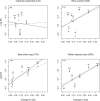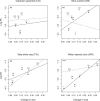Fluctuating asymmetry and environmental stress: understanding the role of trait history
- PMID: 23472123
- PMCID: PMC3589457
- DOI: 10.1371/journal.pone.0057966
Fluctuating asymmetry and environmental stress: understanding the role of trait history
Abstract
While fluctuating asymmetry (FA; small, random deviations from perfect symmetry in bilaterally symmetrical traits) is widely regarded as a proxy for environmental and genetic stress effects, empirical associations between FA and stress are often weak or heterogeneous among traits. A conceptually important source of heterogeneity in relationships with FA is variation in the selection history of the trait(s) under study, i.e. traits that experienced a (recent) history of directional change are predicted to be developmentally less stable, potentially through the loss of canalizing modifiers. Here we applied X-ray photography on museum specimens and live captures to test to what extent the magnitude of FA and FA-stress relationships covary with directional shifts in traits related to the flight apparatus of four East-African rainforest birds that underwent recent shifts in habitat quality and landscape connectivity. Both the magnitude and direction of phenotypic change varied among species, with some traits increasing in size while others decreased or maintained their original size. In three of the four species, traits that underwent larger directional changes were less strongly buffered against random perturbations during their development, and traits that increased in size over time developed more asymmetrically than those that decreased. As we believe that spurious relationships due to biased comparisons of historic (museum specimens) and current (field captures) samples can be ruled out, these results support the largely untested hypothesis that directional shifts may increase the sensitivity of developing traits to random perturbations of environmental or genetic origin.
Conflict of interest statement
Figures



Similar articles
-
Evolutionary history shapes the association between developmental instability and population-level genetic variation in three-spined sticklebacks.J Evol Biol. 2009 Aug;22(8):1695-707. doi: 10.1111/j.1420-9101.2009.01780.x. Epub 2009 Jun 23. J Evol Biol. 2009. PMID: 19555450
-
Fluctuating asymmetry in mice and rats: evaluation of the method.Lab Anim. 2002 Apr;36(2):193-9. doi: 10.1258/0023677021912343. Lab Anim. 2002. PMID: 11943085
-
Fluctuating asymmetry in certain morphological traits in laboratory populations of Drosophila ananassae.Genome. 2006 Jul;49(7):777-85. doi: 10.1139/g06-031. Genome. 2006. PMID: 16936786
-
Fluctuating asymmetry: an epigenetic measure of stress.Biol Rev Camb Philos Soc. 1990 May;65(2):131-45. doi: 10.1111/j.1469-185x.1990.tb01186.x. Biol Rev Camb Philos Soc. 1990. PMID: 2190634 Review.
-
Fluctuating asymmetry: a biological monitor of environmental and genomic stress.Heredity (Edinb). 1992 Apr;68 ( Pt 4):361-4. doi: 10.1038/hdy.1992.51. Heredity (Edinb). 1992. PMID: 1563968 Review.
Cited by
-
Fluctuating asymmetry and feather growth bars as biomarkers to assess the habitat quality of shade coffee farming for avian diversity conservation.R Soc Open Sci. 2019 Aug 14;6(8):190013. doi: 10.1098/rsos.190013. eCollection 2019 Aug. R Soc Open Sci. 2019. PMID: 31598226 Free PMC article.
-
Comparative Antennal Morphometry and Sensilla Organization in the Reproductive and Non-Reproductive Castes of the Formosan Subterranean Termite.Insects. 2021 Jun 24;12(7):576. doi: 10.3390/insects12070576. Insects. 2021. PMID: 34202744 Free PMC article.
-
Filter feeding, deviations from bilateral symmetry, developmental noise, and heterochrony of hemichordate and cephalochordate gills.Ecol Evol. 2020 Nov 3;10(23):13544-13554. doi: 10.1002/ece3.6962. eCollection 2020 Dec. Ecol Evol. 2020. PMID: 33304558 Free PMC article.
-
Fluctuating asymmetry in Menidia beryllina before and after the 2010 Deepwater Horizon oil spill.PLoS One. 2015 Feb 25;10(2):e0118742. doi: 10.1371/journal.pone.0118742. eCollection 2015. PLoS One. 2015. PMID: 25714356 Free PMC article.
-
No relationship found between dental fluctuating asymmetry, birthweight, and birth term in two modern North American samples.Am J Hum Biol. 2024 Sep;36(9):e24114. doi: 10.1002/ajhb.24114. Epub 2024 Jun 6. Am J Hum Biol. 2024. PMID: 38842218 Free PMC article.
References
-
- Anciães M, Marini MA (2000) The effects of fragmentation on fluctuating asymmetry in passerine birds of Brazilian tropical forests. J Appl Ecol 37: 1013–1028.
-
- Lens L, Van Dongen S, Matthysen E (2002) Fluctuating asymmetry as an early warning system in the critically endangered Taita thrush. Conserv Biol 16: 479–487.
-
- Schmeller DS, Dolek M, Geyer A, Settele J, Brandl R (2011) The effect of conservation efforts on morphological asymmetry in a butterfly population. J Nat Conserv 19: 161–165.
-
- Sherman E, Tock K, Clarke C (2009) Fluctuating asymmetry in Ichthyophonus-sp. infected newts, Notophthalmus viridescens, from Vermont. Appl Herpetol 6: 369–378.
-
- Weller B, Ganzhorn JU (2004) Carabid beetle community composition, body size, and fluctuating asymmetry along an urban-rural gradient. Basic Appl Ecol 5: 193–201.
Publication types
MeSH terms
LinkOut - more resources
Full Text Sources
Other Literature Sources
Research Materials

